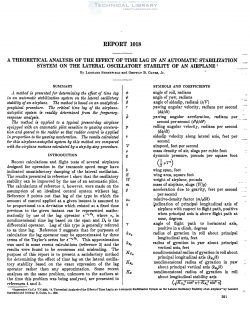naca-report-1018

- Version
- 165 Downloads
- 1.17 MB File Size
- 1 File Count
- September 1, 2016 Create Date
- September 1, 2016 Last Updated
National Advisory Committee for Aeronautics, Report - A Theoretical Analysis of the Effect of Time Lag in an Automatic Stabilization System on the Lateral Oscillatory Stability of an Airplane

A method is presented for determining the eject of time lag
in an automatic stabilization system on the lateral oscillatory
stability of an- airplane. The method is based on an analytical-
graphical procedure. The critical time lag of the airplane-
autopilot system is readily determined from the frequency—
response analysis.
The method is applied to a typical present-day airplane
equipped with an automatic pilot sensitive to yawing accelera-
tion and geared to the rudder so that rudder control is applied
in proportion to the gaming acceleration. The results calculated
for this airplane-autopilot system by this method are compared
with the airplane motions calculated by a step-by—step procedure.
Recent calculations and flight tests of several airplanes
designed for operation in the transom'c speed range have
indicated unsatisfactory damping of the lateral oscillation.
The results presented in reference 1 show that the oscillatory
stability can be improved by the use of an automatic pilot.
The calculations of reference 1, however, were made on the
assumption of an idealized control system Without lag.
Reference 2 points out that lag of the type in which the
amount of control applied at a given instant is assumed to
be proportional to a deviation which existed at a fixed time
previous to the given instant can be represented mat—he-
mat—ically by use of the lag operator eF'D‘, where r. is
nondimensional time lag based on the span and D. is the
differential operator. Lag of this type is generally referred
to as time lag. Reference 2 suggests that for purposes of
calculation the lag operator may be approximated by three
terms of the Taylor’s series for e‘T This approximation
was used in some recent calculations (reference 3) and the
results were found to be erroneous and misleading.
The purpose of this report is to present a satisfactory method
for determining the effect of time lag on the lateral oscilla-
tory stability based on the exact expression of the lag
operator rather than any approximation. Some recent
analyses on the same problem, unknown to the authors at
the time this problem was being analyzed, are presented in
references 4 and 5.
| File | Action |
|---|---|
| naca-report-1018 A Theoretical Analysis of the Effect of Time Lag in an Automatic Stabilization System on the Lateral Oscillatory Stability of an Airplane.pdf | Download |

Comment On This Post